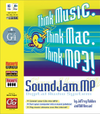SoundJam MP
 SoundJam MP box art | |
| Original author(s) | Bill Kincaid, Jeff Robbin and Dave Heller |
|---|---|
| Developer(s) | Casady & Greene |
| Initial release | July 13, 1998 |
| Final release | 2.5.3
/ April 11, 2001 |
| Operating system | Mac OS 8, Mac OS 9 |
| Type | Media player, handheld device synchronizer |
| License | Proprietary commercial software |
| Website | www.soundjam.com (archived) |
SoundJam MP was an early Mac OS-compatible MP3 player and Rio-compatible hardware synchronization manager that was released in July 1998 and was available until June 2001. Jeff Robbin and Bill Kincaid developed SoundJam MP with assistance from Dave Heller. Robbin and Kincaid chose Casady & Greene to publish SoundJam MP. Apple, Inc. purchased SoundJam MP in 2000 and further developed the code to create iTunes version 1.0. Casady and Greene ceased publication of SoundJam MP in June 2001 at the request of the developers.
History

Prior to working together on SoundJam MP, Jeff Robbin and Bill Kincaid had worked for Apple in the 1990s as system software engineers assigned to the Copland operating system, a project that was abandoned before completion. After the Copland project's cancellation, Robbin and Kincaid left Apple.[citation needed] Robbin went on to create Conflict Catcher, a Mac OS utility, and Kincaid worked at a startup.[citation needed]
Kincaid created Mac-compatible hardware and device driver support for the Diamond Rio line of digital audio players. He then enlisted Robbin to develop the front-end for the MP3-player software they named SoundJam MP.[1] Dave Heller later joined them, completing the core team.[citation needed] The development team chose Casady & Greene to publish SoundJam MP because the company had previously published Robbin's Conflict Catcher.[citation needed] David Pogue wrote SoundJam MP's documentation.[citation needed]
SoundJam MP became a successful product in the Mac music player market, [2] competing with Panic's Audion.
Acquisition
In early 2000, Apple wanted to purchase MP3 player software for use with Apple's desktop computers. Apple sought meetings with both Panic and Casady & Greene. Caught up in negotiations with AOL, Panic was not able to set up a meeting with Apple.[3] Turning instead to Casady & Greene, Apple purchased the rights to the SoundJam MP software in a deal covered by a two-year secrecy clause.[4]
Working as employees of Apple, Robbin, Kincaid and Heller continued to develop the software which would become iTunes.[4] All three continue to work at Apple; Robbin is the lead developer of iTunes.[5][6]
On January 9, 2001, Apple debuted iTunes 1.0 to the public. Curious Macintosh users immediately began poking through iTunes' resource fork, where they discovered numerous strings and other resources that indicated iTunes was a re-engineered SoundJam MP.
After a request from Robbin and Kincaid, Casady & Greene ceased distribution of SoundJam MP on June 1, 2001.[7]
References
- ^ "The True Story of SoundJam". panic.com. Panic Inc.
- ^ Template:Title= Panic History
- ^ Sasser, Cabel (2007). "The True Story of Audion". panic.com. Panic Inc.
- ^ a b dePlume, Nick (2003-07-03). "WSJ: Casady & Greene "forbidden" from discussing iTunes deal". Think Secret. The dePlume Organization LLC. Archived from the original on 2008-01-16.
{{cite web}}: Unknown parameter|deadurl=ignored (|url-status=suggested) (help) - ^ Kahney, Leander (2006-10-17). "Straight Dope on the IPod's Birth". wired.com. Condé Nast.
- ^ Schlender, Brent (2005-02-21). "How Big Can Apple Get?". Fortune Magazine. Cable News Network.
- ^ Chaffin, Bryan (2001-05-06). "Casady & Greene Discontinues SoundJam MP At Developer's Request". The Mac Observer. The Mac Observer, Inc.
